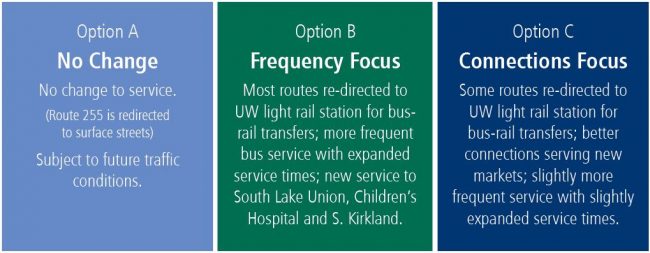SR 520 Service Change Concepts Released
Last evening, Metro and Sound Transit released service change concepts for revised bus service on SR 520. This kicks off the second of three rounds of public input, including an online survey and several open houses in mid- to late June. Because these are service concepts, they do not describe capital improvements in Montlake or elsewhere could be combined with either service option.
Ten routes, six Metro (252, 255, 257, 268, 277, 311) and four Sound Transit (540, 541, 542, 545), are included. Two all-day routes, Metro 255 serving Kirkland-Seattle and Sound Transit 545 serving Redmond-Seattle, carry two-thirds of current ridership. As expected, many buses that currently serve downtown Seattle would be rerouted to UW station freeing resources that would otherwise be consumed in downtown congestion. Changes would take effect ahead of the closure of Convention Place Station, currently scheduled for Fall 2018.
Either alternative improves cross-lake service for most riders, excepting those who prioritize one seat rides to downtown over all else. But the reinvested service hours target different priorities, and many riders will consider their individual circumstances in figuring which option they prefer. A notable highlight of the proposals is that both options include new service between South Lake Union and the Eastside.
Very helpfully, the Metro website separately describes the options, including pros and cons of each, for the major Eastside markets served: Kirkland, North Kirkland/Woodinville, and Redmond. Sound Transit's website has maps for each market under each option: Kirkland, North Kirkland/Woodinville, and Redmond.
After the jump is my summary of the system-wide changes.
Option A: No Change to Service
This is just a benchmark for what will happen if no other action is taken. Metro 255 buses, currently operating in the DSTT would move to the surface. Other bus routes would not change. With space on downtown streets becoming much more constrained, significantly more agency resources are necessary just to maintain current levels of service. Many routes would require up to 10 more minutes to traverse downtown Seattle at peak. Metro 255 would face the greatest degradation in reliability, taking up to 20 minutes longer to the south end of downtown.
Option B: Connect to Link, Focus on Frequency
All downtown service is redirected to UW Link Station, and the savings from avoided downtown congestion are largely reinvested into much more frequent service on major routes. There are some new connections served. There are more buses early and late in the day, and on weekends. About 150 weekday trips are added. A few highlights:
- Metro 255 connects to Link at UW and continues to the U-District. In Kirkland, the 255 would no longer serve stops north of Totem Lake. Metro 235 would serve those customers, increasing 255's reliability. Between Totem Lake and UW, frequencies would be much higher with peak headways as low as six minutes. Headways would be 15 minutes well into the evening and 20 minutes on weekends, all much better than today.
- Several Eastside buses provide new connections to South Lake Union. These include Metro 252 and 257 from North Kirkland, Metro 311 from Woodinville, and ST 542 from Redmond. All of those routes see frequency increases.
- ST 542 serves several new stops, connecting downtown Redmond and Overlake to South Kirkland and South Lake Union.
- ST 545 sees frequency increases with 6-8 minute headways through the peak, with more hours conserved to expand SLU service on other ST routes along the Redmond corridor.
- ST 540 runs every 20 minutes at peak and serve Children's Hospital.
- Metro 277 (Juanita to U-District via Houghton P&R) is deleted. With restructured service, those riders have better options on other routes.
Option C: Connect to Link, Focus on Connections
This option also redirects downtown service to UW Station, but in this case, the frequency increases are more modest and the available service hours target new connections. About 130 weekday trips are added. A few highlights:
- Metro 255 would connect to Link at UW weekday daytimes only, with similar improvements to frequencies during those hours as option B. After 7pm weekdays and on weekends, a new Metro 256 would connect Kirkland to downtown Seattle without a UW stop (same as today's 255). The frequency improvements in daytime hours would not carry over into the hours when the 256 serves downtown directly. So the choice for Kirkland riders on evenings and weekends is between frequency (option B) and direct-to-downtown service (option C). There is some risk of rider confusion as buses switch routes at 7pm under option C. As with option B, 255 would not serve stops north of Totem Lake.
- New Metro route 258 (from Houghton P&R) and ST 542 from Redmond provides direct service to South Lake Union. Both would also serve South Kirkland P&R. The 542 would serve the current ST 545 stops in Capitol Hill and Denny Triangle.
- ST 541 adds a South Kirkland stop and improved connections in the Microsoft area, and is extended to Green Lake. Frequencies and span of service increase.
- Metro 252, 257 (both North Kirkland), and 311 (Woodinville) would continue to serve the north part of downtown Seattle, but not operate beyond Olive Way.
- ST 540 runs every 20 minutes at peak and serve Children's Hospital (same as option B).
- Metro 277 is deleted (same as option B).
The below table sketches out the differences in frequencies between the options.

Headways and span of service under each option. When comparing, remember routes vary across options.
